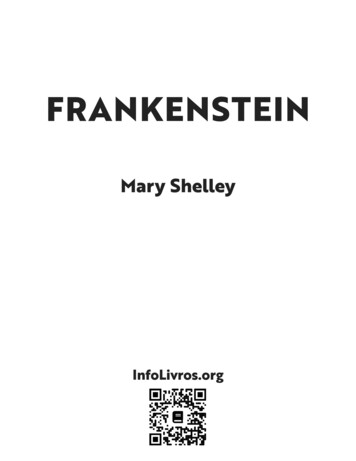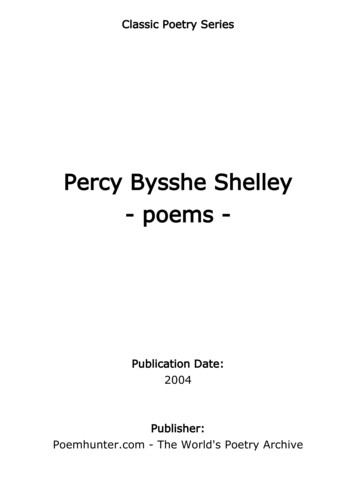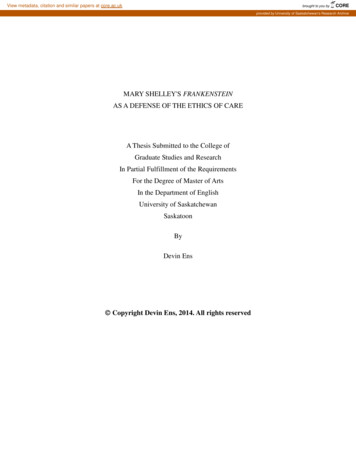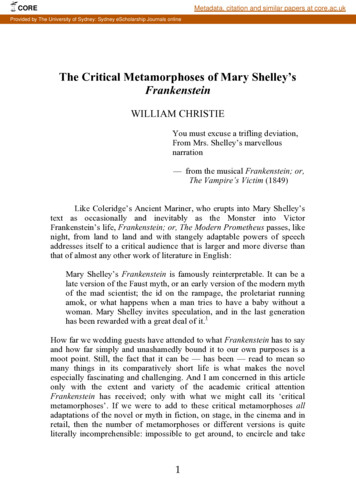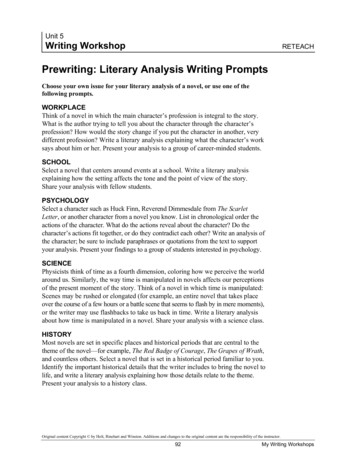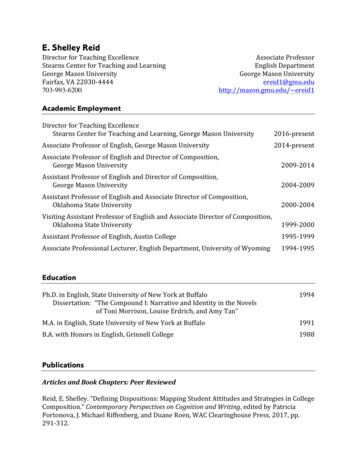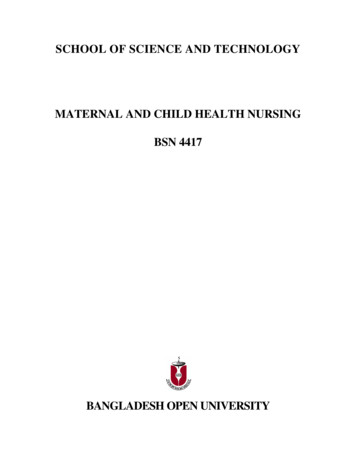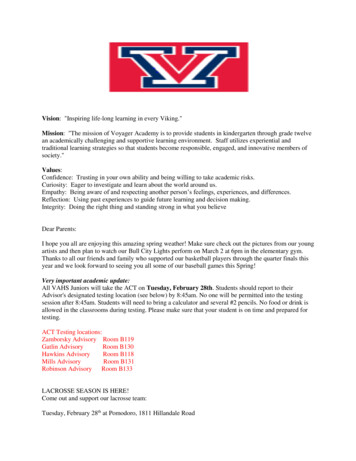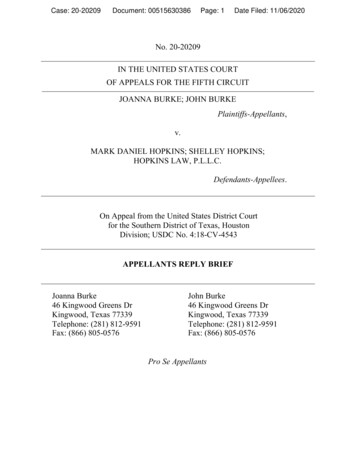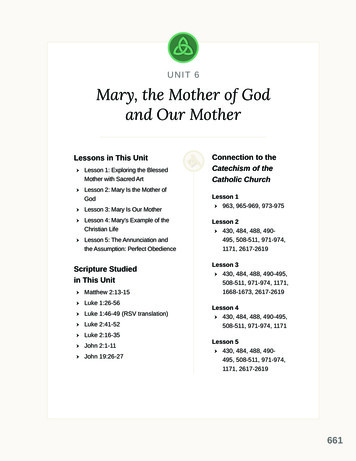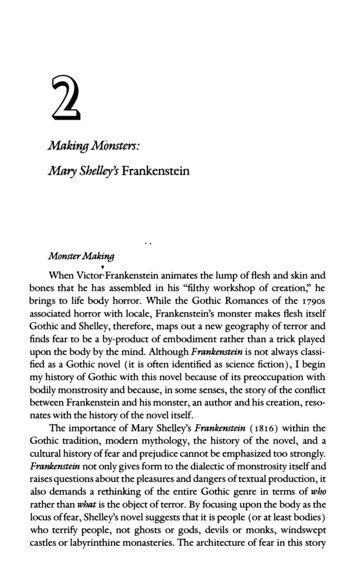
Transcription
Making Mimsters:Mary Shelley's FrankensteinMonster Making·'When Victor·Frankenstein animates the lump of flesh and skin andbones that he has assembled in his "filthy workshop of creation:' hebrings to life body horror. While the Gothic Romances of theI 790sassociated horror with locale, Frankenstein's monster makes flesh itselfGothic and Shelley, therefore, maps out a new geography of terror andfinds fear to be a by-product of embodiment rather than a trick playedupon the body by the mind. Although Frankenstein is not always classi fied as a Gothic novel (it is often identified as science fiction), I beginmy history of Gothic with this novel because of its preoccupation withbodily monstrosity and because, in some senses, the story of the conflictbetween Frankenstein and his monster, an author and his creation, reso nates with the history of the novel itself.The importance of Mary Shelley'sFrankenstein ( I 8 I 6 )within theGothic tradition, modem mythology, the history of the novel, and acultural history of fear and prejudice cannot be emphasized too strongly.Frankenstein not only gives form to the dialectic of monstrosity itself andraises questions about the pleasures and dangers of textual production, italso demands a rethinking of the entire Gothic genre in terms ofwhorather than what is the object of terror. By focusing upon the body as thelocus of fear, Shelley's novel suggests that it is people (or at least bodies)who terrify people, not ghosts or gods, devils or monks, windsweptcastles or labyrinthine monasteries. The architecture of fear in this story
Making Monsters29is replaced by physiognomy, the landscape of fear is replaced by suturedskin, the conniving villain is replaced by an antihero and his monstrouscreation, and the antihero as well as his offspring are both writers andreaders. Meanwhile, the heroine, who in the Gothic Romance was trans ported from one prisonlike structure to another, is now a metaphor forthe domestic prison that threatens to entrap Frankenstein and keep himfrom his solitary, Faust:like enterprise. She is also metonymically linkedto the monster, however, since the grotesqueries of the human form arelinked, in s novel, to an extreme fear of feminine sexual response.1Frankenstein's monster has attained mythic status within both thepopular imagination and the critical project of literary history. Exhaus tive studies ofFrankensteinhave read the monster's symbolic value interms of sex, gender, and class. The monster, in various readings then, isliterature, women's creativity, Mary Shelley herself; the monster is class struggle, the product of industr ization, a representation of the pro letariat; the monster is all social struggle, a specific symbol of the FrenchRevolution, the powef of the masses unleashed; the monster is technol ogy, the danger of science without conscience, the autonomous ma chine. As Franco Moretti so aptly states, like Dracula, Frankenstein'screature is a "totalizing monster''2- one, in other words, who threatensto never be vanquished, one immune to temporary restorations of orderand peace. Totalizing, of course, does not mean essential. Essential mon strosity makes monstrosity an integral feature of very specific bodies;totalized monstrosity allows for a whole range of specific monstrositiesto coalesce in the same form.The "totalizing monster," a modern invention, threatens commu nity from all sides and from its very core rather than from a simple out side. The chameleonic nature of this monster makes it a symbol of multi plicity and indeed invites multiple interpretations. One critic, Marie Helene Huet, inThe Monstrous Imagination,has made the obvious butnecessary connection between monstrosity and prodigious generativity.Huet argues that monstrosity within Romanticism tells of "the darkdesire to reproduce without the other'' and represents art as the resultingprogeny of unnatural reproduction. 3 In general, however, various criticshave attempted to narrow the scope of monstrosity inFrankensteininorder to theorize fear and a semiotic of horror. Such critical accountstend to exclude or de-emphasize the monster's status as hybrid in favorof specific class- or gender-inflected readings. In any attempt to fix mon strosity, some aspect of it escapes unread. Moretti, for example, having
30Skin Showsnamed the monster as "totalizing;' also makes a strong case for the mon ster as the proletariat, "a collective and artificial creature"( 8 5) . Describ ing Frankenstein himself as the bourgeois subject conscious of "havingproduced his own grave-diggers"( 8 6 ) , Moretti goes on to suggest thatFrankenstein and his monster are unable to play out their proper roles asowner and worker because, for Shelley, "the demands of productionhave no value in tht;mselves, but must be subordinated to the mainte nance of the moral and material solidity of the family''( 90 ) .Moretti understands the technology of the monster narrative tobe one hich subordinates class to family but in fact it is crucial torecognize that monsters play precisely upon the boundaries that seem toneatly delineate family from class, personal from economic, sexual frompolitical. Owner and worker relations, in other words, are preciselyplayed out in family relations; the narrative of family is indeed the sen timentalized version, or in *.is case the gothicized version, of classstruggle and race war. Shelley'sFrankensteinconfirms, in fact, that theconstruction of the; monster facilitates rather than emanates from theconstruction of "the family.'' The family, indeed, in this novel, is as frag mented and incoherent as the monster himself and it only takes on aglow of authenticity in the absence of all family members. Hence, at theoutermost frame of the novel we have a reader, Mrs. Saville, Walton'ssister, a married woman who rests comfortably at home in England.Mrs. Saville represents the way that home and family exist as imaginarylimits to the narratives of voyage and discovery. At the innermost frameof the novel, of course, we have a picture-perfect family but the familyin question represents domestic bliss as the union of a European man(Felix) and his subjugated Oriental bride (Safie) . As Joseph W. Lewcomments in an article, "The Deceptive Other: Mary Shelley's Critiqueof Orientalism inFrankenstein,"this family represents itself as the safehaven of the Oriental woman from the barbarity of the East. 4When Moretti does touch briefly upon the fact that the monster ofclass may also be representative of other forms of monstrosity, he seemsunable to recognize the full significance of the potentiality of any oneform of othering to become another. He remarks upon Frankenstein'sfear that his monster, if given a mate, will bring a "race of devils" into theworld; Mary Shelley, according to Moretti, at her most reactionary,turns the class other, the proletariat, into a "race of devils" and so, heclaims, she transforms a historical product into a "natural" and immuta ble category. But Moretti has also transformed one category into another
Making Monsters3Ihere; he has assigned class to the order of the artificial and he has natu ralized race. A reading of Gothic monstrosity attuned to the specifictechnology of monsters demands that identity itself be readasa con structed category, one. that depends heavily upon the mutual and inter dependent constructions of race, class, and gender. 5The very project of interpretation in this novel, I am saying, iscomplex and unstabl and it is this instability, in part, that generates theinfinite interpretability of the monster. As Daniel Cottom writes: "Fran kenstein's monster images the monstrous nature of representation.''6 The·monster defies definition just as the novel itself seems to challenge neatgeneric categories. The question, What is it? in other words, has to bedirected both at the book and the monster. Indeed, the connection be tween the two is made perfectly clear by Mary Shelley in her introduc tion when she dubs her book "my hideotis progeny'' and bids it "go forthand prosper.'' The question th haunts the monster, Who am I? is re peated in critical gestur s toward the novel that ask, What is it? Theanswer, of course, li s in the impossibility of pinning definition to thispeculiar form.The form of the novel is its monstrosity; its form opens out ontoexcess because, like the monster of the story, the sum of the novel's partsexceeds the whole. Its structure, the exoskeleton, and not its dignifiedcontents- philosophies of life, meditations on the sublime, sentimentalnarratives of family and morality, discussions of aesthetics- makes thisnovel a monster text. The monstrosity ofFrankensteinis literally builtinto the textuality of the novel to the point where textual productionitself is responsible for generating monsters.Because definition is beside the point, then, the questions to directat the monstrous book are( 2)(3)(I)what exactly constitutes its productivity?,how does it reproduce within the domain of interpretation?, andare we, the readers, the "race of devils" that Frankenstein feared hewould loose upon the world? I want to answer these questions by look ing closely at the narrative form of the novel and then by suggesting thatpossibly the novel plays out an allegory of Gothic fiction itself, or thatthe Gothic plays out an allegory of the production of the novel. Thereare, of course, in this text, two monsters that Frankenstein attempts tobring to life, one male and one female. The aborted female monster canbe read as the ugly popular fiction, Gothic fiction, that is always debasedin relation to some notion of high culture. She is the body of work that isalways "half-finished:' that inspires violence, and that literally is reduced
32Skin Showsto pulp. This relationship between popularity and population (since thefemale monster represents precisely Frankenstein's fear of a monstrousreproduction) needs to be thought through in relation to recent histo ries of the novel and o the main narrative of human versus monster thatFrankenstein and his creation enact.I suggest that the book presents itself not as the making of a mon ster but as the making of a human. In what ways does the monsterconstruct Frankenstein, in other words? Who actually builds whom andwho destroys whom? The construction of the human will frame mydiscussion of monstrosity throughout this book and in relation to thisnovel, I am concerned to link the construction of humanness to a splitwithin the novel between popular and high culture but also to the de pendent histories of race, nation, gender, and sexuality. The identity of aFrankenstein, in other words, always depends utterly upon the variouslines of constructions that coalesce in his humanity. His humanness de pends as much upon his status as male, bourgeois, and white as the.monster's monstrosity depends upon his yellow· skin, his gargantuan'size, his masslike shape, and his unstable gender. First, however, let'slook at the machinery, the textual machine, that generates meaning inFrankenstein.Monstrous FormsThe framing device which structures Frankenstein skews perspectiveand complicates relations between author and narrator, author and read ers, and between characters. The novel's first frame (although "first'' is acontested notion in this novel, and this frame is already preceded by theauthor's introductions and an epigraph from Milton's Paradise Lost) is aseries of letters from Walton to his sister, Margaret Saville (whose ini tials, M. S., of course, suggest the confiation of author, Mary Shelley; andreader, Margaret Saville; and manuscript) . Next, we read in Walton'sjournal of his meeting with Victor and his transcription ofVictor's story.Within Victor's story we read letters from Elizabeth and then the mon ster's story. The monster recounts his discovery ofVictor's journal withinhis description of how he came to know himself as monstrous and hu man in his time spent with the De Laceys. We return finally to Walton'sship, the Archangel, to Victor's deathbed. Victor dies and the monsterdisappears into the darkness.Frankensteingenerates stories and narrative perspectives like a rna-
Making Monsters33chine. Chris Baldick's study, In Frankenstein's Shadow, contrasts the con struction of the monster from fragments of corpses to the structure ofthe novel as an aggregate of narrative pieces and furthermore, to theabsorption and reproduction by Mary Shelley of a mass of literary influ ences from Milton to the writings of her mother and father. Baldicksuggests that "there is a fund of literary sources upon which Frankensteincannibalistically fee ?'7 Baldick's notion of cannibalistic activity is, Ithink, extremely important to both Frankenstein and the Gothic genre ingeneral. Bram Stoker's Dracula also functions according to a model ofconsumption and production; it too assembles a writing machine fromletters and journals, dictaphones and phonographs; it too feeds can nibalistically on its sources. The structures of both Frankenstein andDracula activate and exemplify models of production and consumptionwhich suggest that Gothic, as a genre, is itself a hybrid form, a stitchedbody of distorted textuality. s. model also has obvious links to the cap italist structures that pro4uced the novel as a commodity which broughtincome to writers was paid for by (mostly middle-class) readers.In order to explain the cannibalistic activity that I think is associatedwith Gothic form, I want to link Baldick's comment about Frankenstein'scannibalistic activity to a theory advanced by Nancy Armstrong in Desireand Domestic Fiction of the "omnivorous behavior'' of the novel. I quote:[I]f, as I believe is the case, the novel contains the history of sex uality within it, then its own history- the history of fiction- isdisplaced along with that "other" history. Given the omnivorousbehavior I am attributing to the novel, there is very little culturalmaterial that cannot be included within the feminine domain. Con sequently there is very little political information that cannot betransformed into psychological information. 8Armstrong shows how "omnivorous behavior" in the novel means thatdomestic fiction participates in, rather than represents, the production offemale subjects. Furthermore, by transforming political identities intosexual identities, political resistance is diffused by the novel and "thefeminine domain" remains in bondage to a metaphysics of gender.Gothic, I suggest, beginning withFrankenstein,isatextual ma chine, a technology that transforms class struggle, hostility towardswomen, and tensions arising out of the emergent ideology of racism intowhat look like sexual or psychosexual battles between and within indi viduals. The monster is consistently read as his maker's alter ego, as his
34Skin Showsunconscious, as the return of the repressed. Moretti, who otherwiseconcentrates on the materialist dimensions of the monster, claims thatthis figure cannot be adequately explained by recourse to economic orhistorical terms and he suggests that the monster is "the rhetorical fig ure" that both "expresses the unconscious content and at the same timehides it" ( 1 o 3 ) . The monster as metaphor, still according to Moretti,transforms social d psychic fears ("the fear of monopoly capital andthe fear of the mother'') into other forms "so that readers do not have toface up to what really frightens them"( 1 o 5) .Moretti's marxist-based notion that monsters allow for the expan sion and enrichment "of the structures of false consciousness" differssignificantly from the kind of transformation that I am noting in terms ofGothic technologies. Monsters, like the one Franken tein builds, em body a multiplicity of fears and invite ·the reader to participate in chart ing the shapes and contours of each one. Most often, the postpsycho analytic modern reader assumes that Gothic monstrosity occupies aprivileged relation to a psychology of horror but this assumes the trans ,historical availability of psychic interpretations and understandings ofthe self. The reason we can read the monster as a psychic structure isbecause the monster can take the imprint of that interpretation not be cause that interpretation most usefully describes monstrosity. Monstersappeal to readers and consumers because they represent in their veryform the game of reading and writing, rewriting and telling, telling andinterpreting. False consciousness is simply not an issue here because noreading is false. The cannibalism of the Gothic form, its consumption ofits own sources, allows for the infinitude of interpretation because eachfear, each literary source, each desire, each historical event, each socialstructure that the text preys upon becomes fuel for the manufacture ofmeanings.Frankenstein's monster in particular, since he is given a voice, com plicates the cannibalistic narrative structure by participating in it even ashe is revealed as a product and a symbol of that structure. The narrativeframes, furthermore, allow us to trace the transformations that take placein Gothic of racial, sexual, historical, and psychological into metaphoric,of productive into representative. Furthermore, the Gothic form is im plicated in the monstrosity it produces because, as a mutation of classicrealism, it is regarded as an ugly, clumsy, and fantastical genre. And themonster -like the "wophagous" Renfield in Dracula who desires "toabsorb as many lives as possible" by eating cats that have eaten mice that
Making Monsters35have eaten spiders that have eaten flies-the monster can· be brokendown into the lives and forms he has absorbed.Eve Sedgwick's discussion of the trope of "live burial" has obvi ous significance to a theory of Gothic's cannibalistic nature. Sedgwickwrites: "If the story-within-etc. represents the broadest structural ap plication of the otherwise verbal or thematic convention of the unspeak able, it has a similar rel tion to the convention of live burial?'9 Sedgwickis interested in charting a topography of Gothic where a certain spatialrelation pertains to the tropes of inside and outside, live burial, and theunspeakable in Gothic. Gothic, then, according to Sedgwick, is markedby a doubleness of space created violently by the destruction of bound aries. One space (inside, silence, nightmare) encroaches or feeds uponanother (outside, speech, experience) as the difficulty of telling becomesa part of the act of confession. Ultimately, for Sedgwick, language per forms the operations of the unc y so that the unspeakable is buriedalive within the speakable, one story lies buried in another, one historyproduces and buries oVters.InFrankensteinit· is identity itself which is buried alive, or ratherwhich is figured as live burial. The epigraph to the novel, Adam's ques tion to God in book1 o of Paradise Lost, "Did I request thee, Maker, frommy Clay /To mould me Man?" already conceives of the human as some thing that has been built, in this instance by God from clay. Obviously,the relationship between Victor Frankenstein and his monster parodiesthe relationship between God and Adam/Satan/Eve but it also replacesa divine relation with a secular one. The epigraph setsFrankensteinupagainst the most authoritative creation myth in Western culture but itis crucial to note that the novel is not comparing itself to the creationstory but rather to its literary recounting in Milton's epic poem. Origins,inFrankenstein,are always literary or textual rather than religious orscientific.Furthermore, the question posed by the epigraph emphasizes theproblem of definition-what is human? what is a human relationship?how do we recognize humanity? These become questions that this noveldirects specifically at the problem of form. In this novel the monster isnot human because he lacks the proper body-he is too big, too ugly,disproportionate. He is also a question directed at nature; Frankensteinhad hoped to discover "nature's secrets" with his creation but his mon ster is no answer to nature's mysteries, so-called, he is simply anotherquestion. He is the body that produces the natural and the human as
36Skin Showspower relations and his is the body that uses up natural and humanremains in order to recycle flesh into scientific invention.By marking Gothic as cannibalistic, as an essentially consumptivegenre which feeds pa rasitically upon other literary texts, I want to drawattention to the violence with which the form erases boundaries andconsumes stories and lives in order to produce fear. The production offear is, therefore, the result of a technology that simultaneously producesan epistemological risis. The reading subject (but also the charactersand seemingly the writer) of the Gothic is constructed out of a kindof paranoia about boundaries: Do I read or am I written? Am I monsteror monster maker? Am I monster hunter or the hunted? Am I humanor other? For the modem reader such questions might seem to circlearound sexual identity, Who/what do I desire? But nineteenth-centurymonstrosity confounds the possibility of a single answer to the questionof identity. If we read Frankenstein as a story about repressed homoeroticdesire, for example, we risk not reading it as a story about childbirth; andif we only read it as a "birth myth;' we miss the narrative of class.'Narrative resolution in Gothic fiction, of course, usually resolvesboundary disputes by the end of the novel by killing off the monster andrestoring law and order but fear lingers on because after all, in Franken stein the monster as subject is produced through the reading of texts. Themonster comes to knowledge, self-knowledge, by reading the books hefinds at the De Laceys' and finding himself in his own drama of identi fication. After reading Paradise Lmt, for example, he is compelled to askwhether he is another Adam "apparently united by no link to any otherbeing in existence?'10 But, he concludes, "I considered Satan as the fitteremblem of my condition" ( 1 29 ) . Feminist critics have also noted a re markable resemblance between the monster and Eve.11 Notice, however,that nothing is gained by fixing the monster to one of these identities.While the epigraph to Shelley's book suggests strongly that, in his dramaof creation, the monster is indeed Adam, asking, like Adam, "Did Irequest thee, Maker, from my Clay I To mould me Man?" the feministreading that identifies bodily monstrosity with a fear of femininity de mands that the monster be stabilized as female; and the conventionalreading that understands the monster as flawed humanity makes himinto a kind of Satan figure.The monster is always all of these figures. By his very composition,he can never be one thing, never represent only a singular anxiety. Hisformation out of bits and pieces of life and death, of criminals and
Making Monsters37animals, animate an d inanimate objects means that h e i s always i n dan ger of breaking down into his constitutive parts. It is the propensity forthe monster to deconstruct at any time, to always be in the process ofdecomposition, that mak it/him/her a fugitive from identity and amodel for the Gothic reader.It is also a kind of ahistorical desire on the part of the modem readerthat seeks an an.wer to the question of identity in the form of the mon ster. By demanding that the monster round out our definitions of "hu man" (either by representing a polar opposite or by showing "real hu 'manity") we also remake the monster as alien, as other, as difference. Themonster, in fact, is where we come to know ourselves as never-human, asalways between humanness and monstrosity. Just as, for the monster,paradise is always lost inFrankenstein,so, for the reader, humanity humane treatment of others, justice, etc. - is always beyond our reach.After Justine has been killed for the death of William, Elizabethmourns for her lost vision of the "hUman":''When I reflect my dear cousin,:' said she, "on the miserable deathof Justine Moritz,1 no longer see the world and its works as theybefore appeared to me. Before I looked upon the accounts of viceand injustice, that I read in books or heard from others, as tales ofancient days or imaginary evils; at least they were remote, and morefamiliar to reason than to the imagination; but now misery hascome home, and men appear to me as monsters thirsting for eachother's blood."( 92-9 3 )This is a remarkable statement of an antisentimental view of humannature which is all the more powerful in that it comes from Elizabeth,the representative of family and community in the novel. Elizabeth veryaccurately describes how the human is a complicated structure that de pends at least in part upon a vision of progress from past "vice andinjustice" to present equity and humanity; she recognizes that "talesof . . . imaginary evils" construct a vision of false harmony within apresent tense; and finally she acknowledges that "now misery has comehome, and men appear to me as monsters." The bleeding of one categoryinto another that we have noted as a feature of Gothic takes on a verysignificant function here. Elizabeth really gives us the key to Shelley'snarrative in this speech. Monster seeps into the category of man as justicemiscarries and misery comes home. It is the human that falls into doubtat this crucial moment; it is the human that seems to be a patchwork of
38Skin Showsmorality, criminality, subterfuge, and domesticity, and one which barelyholds together. Elizabeth, indeed, at crucial moments in the narrativefails to distinguish between man and monster and this becomes the newrole of the heroine in Gothic. Where the heroine fails to distinguish, thedistinction fails to hold. So, in Dracula, as we will see, Lucy and Mina areboth seduced by the vampire and they fail to distinguish between his biteand the proper pem;trations of their husbands and fiances.The production of the monster by Frankenstein throws humanness!into re ief because it emphasizes the constructedness of all identity.While superficially this novel seems to be about the making of a monster,it is really about the making of a human. It is also about the destructionof otherness, theunmakingof monstrosity that is demanded by thesentimental narrative of conquest, voyage, and discovery. Frankenstein'srelationships with Clerval and Walton; his dependence upon other menfor his own masculinity, means that he must repudiate both the mon .ster's plea for empathy and the possibility of a female monster.'Visual Horror and NarrativeBeautiful!- Great God! His yelWw skin scarcely covered the work of muscles andarteries beneath; his hair was of a lustrous black, and flowing; his teeth of apearly whiteness; but these luxuriances onlyformed a more horrid amtmst withhis watery eyes, that seemed almost of the same colour as the dun white sockets inwhich they were set, his shrivelled complexWn and straight black lips. (S7)Frankenstein's monster's skin barely covers his interior -the mon-ster is transparent. The features that should make him beautiful, further more, "lustrous black" hair and "teeth of a pearly whiteness;' look hid eous because they are out of place in relation to the "watery eyes" and"shrivelled complexion?' The monster is both skintight and "shrivelled;'he has beautiful features set next to extreme ugliness. The whole impres sion is underscored by the "straight black lips" -evidence of a lack ofinternal circulation, evidence of the borrowed nature of all of his mostnecessary features. All in all, the monster is the obscenity of the surface,unwatchable, a masterpiece of a horror that cannot be viewed withoutterror.Frankenstein is the granddaddy of Gothic filmfilm, after all, depends upon a certain degree of un-It is no surprise thathorror. The horror
Making Monsters39watchability. Cinematic horror also asks that the monster become a kindof screen onto which the spectator's fears are projected. In a way, Fran kenstein establishes the preconditions for cinematic horror and for horrorto become cinematic by. making the monster's monstrosity so definitivelyvisual. Orily a blind man can accept the monster uncritically in this noveland, in a way, the blindness of old De Lacey represents also the blindnessof the reader. We are disposed as readers to sympathize with the monster because, unlike the ch acters in the novel, we cannot see him. Once themonster becomes visible within contemporary horror films, monstrositybecomes less and less recuperable.The monster inFrankenstein establishes visual horror as the mainstandard by which the monster judges and is judged. The most centralepisode in the novel, the narrative of the De Lacey family, establishesvisual recognition as the most important code in the narrative of mon strosity. The story of the De Lac ys is buried within the monster's story,their story is a subset of his, but his story (history) becomes a model ofhistory itself as he learps of"the strange system of human society'' and of"the division of property, of immense wealth and squalid poverty; ofrank, descent, and noble blood" ( 1 20 ) .Just as the monster readsParadise Lost as "a true history;' so "truehistory'' is reduced to the story of one family at the innermost recess ofthe novel. True history and fiction trade places so that the story of thefamily replaces the story of nations; and the narrative of the body re places the history of creation; and the significance of visual codes be comes greater than that of heritage. The fiction of the monster replacesthe history of discovery and invention that first Walton and then Fran kenstein try to tell. And through these series of substitutions, the "truehistory'' of the world boils down to the monster's reading list, a quirkycanon of stories for underdogs, and a tale of subjectivity as a self knowledge that inheres to the human.But humanity as well as monstrosity, in this novel, depends uponvisual codes for its construction. The w
between Frankenstein and his monster, an author and his creation, reso nates with the history of the novel itself. The importance of Mary Shelley's Frankenstein (I 8 I 6) within the Gothic tradition, modem mythology, the history of the novel, and a cultural history of fear and prejudice cannot be emphasized too strongly.
